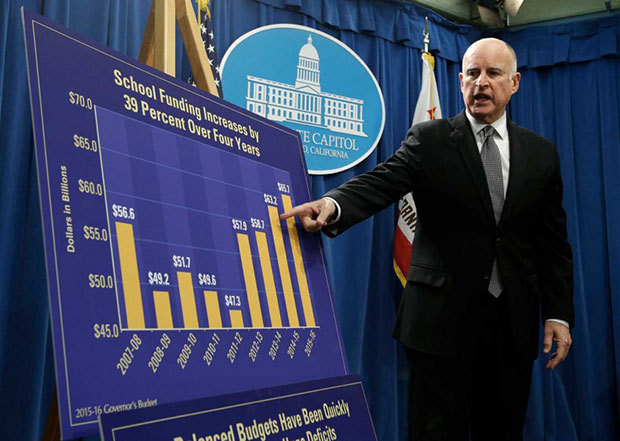Jerry Brown’s budget battle starts with $120 million threat to UC

By Melody Gutierrez
SACRAMENTO — Gov. Jerry Brown preached fiscal restraint Friday in opening six months of state budget negotiations with lawmakers, then sent a similar message to University of California leaders whose recent vote to raise tuition by 28 percent over the next five years drew his ire.
Brown’s message: Rescind the tuition increases or lose $120 million in the next fiscal year.
Brown’s record-high $113.3 billion general fund budget proposal for the 2015-16 fiscal year did not include the additional $100 million the university system said was needed to avoid tuition increases. Brown’s proposal did offer a previously promised 4 percent annual increase — contingent on UC keeping tuition flat and capping the number of lucrative out-of-state and foreign students the system admits.
“The University of California is created by the people of California,” Brown said Friday. “It’s historically been for the citizens of the state. Yes, it’s good to have some foreign students and some out-of-state people, but I don’t think that should be viewed as a financial mechanism.”
UC President Janet Napolitano said she was disappointed Brown did not include “sufficient revenue” for the university, but she’s hopeful future discussions will change that.
The budget plan handed the California State University system, which has not threatened a tuition increase, its promised 4 percent raise of $120 million plus an additional $25 million in order to help students finish their degrees faster.
Brown and Napolitano have tussled over UC’s plans to raise tuition. Brown, an active member of the UC Board of Regents, has called on the university to reduce spending, offer more online classes and limit faculty and executive pay raises. He said he is working collaboratively with Napolitano to look at ways to reduce costs at the university.
Brown said he doesn’t doubt more money would be put to good use.
Brown’s ‘good’ and ‘bad’
“Most of the money is going for a good,” Brown said. “Therefore, if you say you want less good, that feels bad. But if all you do is hand out goods, it is bad.”
Napolitano said Friday in a statement that the university is receiving $460 million less in funding from the state than it did in 2007 even though it’s educating thousands more California students. She said the $100 million in additional funding the university sought is needed to keep tuition flat and increase enrollment amid record-high applications.
“The regents say more money, the governor says more accountability — we say both,” said Todd Stenhouse, spokesman for the American Federation of State, County and Municipal Employees Local 3299, UC’S largest employee union representing thousands of service and patient care workers.
Both university systems each receive $762 million in the budget proposal.
Brown’s 2015-16 spending plan also included:
• $8 billion in additional funding for K-12 schools and community colleges, including nearly $1 billion in money owed to schools during the recession.
“Gov. Brown’s budget proposal for community colleges is the best our system has seen in years,” California Community Colleges Chancellor Brice Harris said in a statement. “It proposes additional funding that will make seats available for 45,000 more students.”
• $532 million from Proposition 1, the water bond voters passed in November, for water recycling, groundwater sustainability and other measures.
• $1 billion toward investments in low-carbon transportation, sustainable communities, energy efficiency and high-speed rail using cap-and-trade revenue.
• $1.2 billion in funding for workforce training, such as adult education and other training programs.
Brown said he wants to continue to pay down the state’s wall of debt and create savings through the state’s newly revised rainy day fund. Brown proposed putting $2.8 billion into the rainy day fund. California faces $222 billion in retirement-related obligations, such as unfunded pension liabilities.
Brown proposed tackling the $72 billion unfunded liability for retiree health care benefits by increasing contributions from public employees and the state through a cost-sharing agreement that would have to be negotiated with labor unions as their contracts come up for renewal.
‘It’s a good budget’
“Overall, it’s a good budget,” said Senate Republican Leader Bob Huff of Diamond Bar (Los Angeles County). “This is a January budget and the final budget isn’t until June. This is basically a floor and there is already $5 billion more in general fund (spending) than last year.”
Advocates for the poor staged rallies in five cities, including San Francisco, on Friday to call on Brown to tackle the “wall of poverty.” Democratic leaders have urged Brown to prioritize social spending in the past two years as the state’s economic recovery dropped billions of dollars in unanticipated revenue into state coffers.
Brown said he is sensitive to the struggles faced by those living in poverty as he recounted driving mothers to find shelter at night when he was mayor of Oakland. He said California is doing more than most states to help those in need, but he said he has to strike a balance that ensures the state is on secure financial footing for the future so that pivotal programs aren’t cut again.
“There is only so much money here,” Brown said Friday. “It’s easy to say let’s do that, let’s do that. I look at it in the aggregate and the aggregate is the liabilities are far exceeding the surpluses that we are looking at.”
Chronicle staff writer Nanette Asimov contributed to this report.
[Source]: SF Gate


